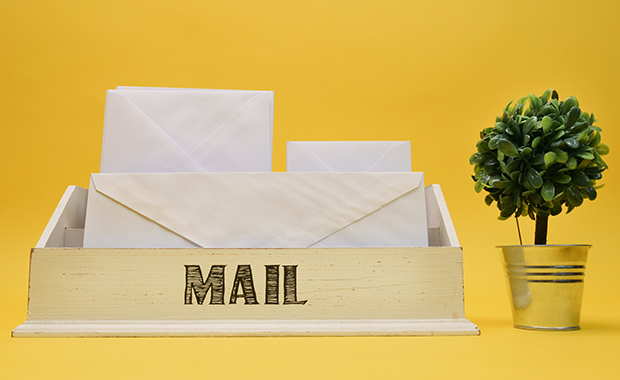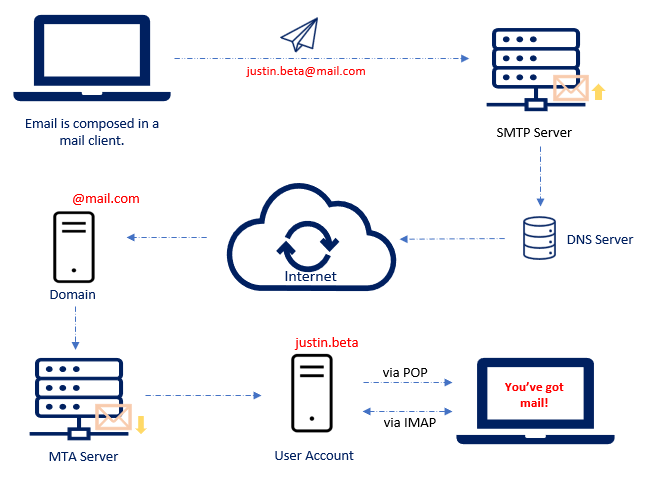How does email work?
Have you ever wondered what happens with your email after you hit Send? Email is something we use every day, but most of us don’t know what happens behind the scenes to transmit our message from point A to point B. mail.com explains the steps your email takes along the way – and don’t worry, we promise not to get too technical!

- When did we start sending email?
- How do emails get sent and received?
- How to send an email
- How to receive an email
- What to do when email delivery doesn’t work
- Do I need Wi-Fi or data to send email?
When was the first email sent?
In early days of computers, it was only possible to send messages within a single system, but in 1971 Ray Tomlinson came up with a way to send electronic mail to users on other systems, in effect inventing the email. From that point on, standards and protocols were developed that allow us to send messages to one another over the shared network of the internet.What happens when an email is sent?
Let’s start with what happens when you write an email. For this you use an email client, which is a computer program that lets you access your email account – for example, Outlook or the mail.com Mail App. This is where you compose your message and type in the recipient’s email address containing a domain name like @mail.com.Once you press the Send button, your message needs to be formatted so it can be transmitted over the internet using a standard called the Simple Mail Transfer Protocol (SMTP). Basically, your message needs to be sent between servers, and SMTP is how they communicate with each other.
Now your email client connects to its mail server, the Mail Transfer Agent (MTA), which will send out your email. So it knows where your message needs to go, the MTA has to contact a Domain Name System (DNS) server, which translates the domain portion of your recipient’s address into an IP address. It then searches the internet for the destination mail server, or Mail Exchange Server (MX), associated with that IP address. This tells it where to send your message.

Once it is clear where your message should be delivered, it is transmitted to the recipient’s MTA. After it arrives at the destination mail server, it can be retrieved by your recipient’s email program using a standard such as the Post Office Protocol (POP) or Internet Message Access Protocol (IMAP). It is then placed in their inbox, where it can be read.
How to send an email
Sending an email does not have to be a lengthy process. The mail.com Mail app and web browser re-enforces the ease of email sending. Email message sending has many variables, but you’re here just for the basics, so have no fear.- Open mail.com on your web browser and log in to your account. If you are new, you can create an email account in just a few minutes.
- Under the ‘Home’ tab, you can click ‘compose email’ in the bottom left-hand corner of your email overview.
- Now, you can begin composing your email. In the ‘To’ field, you will add you recipient(s). You can also add your recipient(s) in the CC/BCC fields.
- Add your subject. This field let’s your recipient know what the email is generally about
- Now you’re ready to compose your message. If you’re responding to an upsetting email, keep in mind to read your email message more than once.
- Make sure you’ve double, and triple checked your recipient, subject, and email message.
- Now simply select ‘Send’ next to the ‘To’ field.
How to receive an email
Email message delivery does not require much work from your side, especially if you are waiting for an important email. Don’t drive yourself crazy wondering if you received that email. As soon as you log into your email account, mail.com will tell you exactly how many new unread emails you have to help you keep track of your email message flow.- Open mail.com in your browser and log in
- Under the ‘Home’ tab you can see you email overview, in which your total of unread emails will be visible. You can also see your most recent emails from the last 7 days.
- Click on ‘Unread e-mails’
- You are brought to your inbox and can check for that long-awaited email there.
What to do when email delivery doesn’t work
Did you send an email, but your recipient says they have not received it? Or have you been told someone has sent an email to you, but it is literally not in your inbox? These questions are the importance of email delivery in the sending and receiving emails process. If you’re unsure if your email was delivered there is indeed a way to check.My recipient says they don’t have my email
- Open the mail.com browser and log into your mail.com email account.
- Click the ‘E-mail’ tab
- Search the ‘sent’ and ‘draft’ folder for the email in question. If you cannot find the email, it is possible that you did not send it at all or it was deleted in the process.
- Wait for a few hours to see if you get a delivery error message. Happens to the best of us and there are multiple reasons for why that would happen.
- Ask your recipient to follow the steps of ‘someone sent me an email, but I don’t have it’
Someone says they sent me an email, but I don’t have it
- Open the mail.com browser and log into your mail.com email account.
- Click the ‘E-mail’ tab. Your inbox is now open, in the search bar on the left side of your inbox, you can type in a keyword to search for this mysterious email. You can search the sender’s name, email address, or the subject/contents of the email
- Still not there? Click on the ‘spam’ folder and you can look for the email there.
- If you have found it in the ‘spam’ folder, you can manually mark the email as ‘not spam’ and it will be moved to your inbox. This also allows the sender to be added to your list of trusted senders.
- If you need more help with this, see our deep-dive on finding missing emails
Bonus explainer: Does email work without Wi-Fi and does email use data?
What a good question! Wi-Fi and data are the main ways that people send and receive emails. If you do not have Wi-Fi, your email programs on your smartphone will use data as a default because it is assuming that you are not around a sufficient Wi-Fi connection. The data used for accessing you email is a small amount because the email client has to be able to communicate with the servers that allows for the sending and receiving of emails. If we subtract Wi-Fi and data from the equation, you will notice that you have a limited set of functionalities because you will not be connected to the internet to send and receive emails. Your functionalities depend on the server your email provider uses. Without Wi-Fi or data, you can see your mail.com email previews in the inbox; however, if you select them, you won’t be able to load the email.
With mail.com, you are in luck if you’re experiencing the common scenario of trying to access important files and do not have Wi-Fi or data to use. In the mail.com Mail app, you can download these individual files in your mail.com Cloud to your phone while you are still connected to the internet. You can then use them whenever you’re off the grid. The mail.com web mail also allows you to download files in your Cloud for offline use with the cloud sync tool. And If you have an email in mind that you need to write, especially while it is fresh on your mind, you can compose an email offline on the mobile email app on your phone. Once your email is all typed up, you can then click ‘Cancel’ and you will get the option to save your email as a draft. And voila! When you’re back online, you can simply go to your drafts and press ‘Send.’
What a good question! Wi-Fi and data are the main ways that people send and receive emails. If you do not have Wi-Fi, your email programs on your smartphone will use data as a default because it is assuming that you are not around a sufficient Wi-Fi connection. The data used for accessing you email is a small amount because the email client has to be able to communicate with the servers that allows for the sending and receiving of emails. If we subtract Wi-Fi and data from the equation, you will notice that you have a limited set of functionalities because you will not be connected to the internet to send and receive emails. Your functionalities depend on the server your email provider uses. Without Wi-Fi or data, you can see your mail.com email previews in the inbox; however, if you select them, you won’t be able to load the email.
With mail.com, you are in luck if you’re experiencing the common scenario of trying to access important files and do not have Wi-Fi or data to use. In the mail.com Mail app, you can download these individual files in your mail.com Cloud to your phone while you are still connected to the internet. You can then use them whenever you’re off the grid. The mail.com web mail also allows you to download files in your Cloud for offline use with the cloud sync tool. And If you have an email in mind that you need to write, especially while it is fresh on your mind, you can compose an email offline on the mobile email app on your phone. Once your email is all typed up, you can then click ‘Cancel’ and you will get the option to save your email as a draft. And voila! When you’re back online, you can simply go to your drafts and press ‘Send.’
This whole sending and receiving email process happens much more quickly than the amount of time it takes to describe it – if you sent off an email right before you started reading this article, the odds are that it will have arrived and might even be responded to by the time you’ve finished reading this article!
We hope you enjoyed this peek behind the scenes about the send and receive email process! Please leave us some feedback below!
175 people found this article helpful.
Related articles